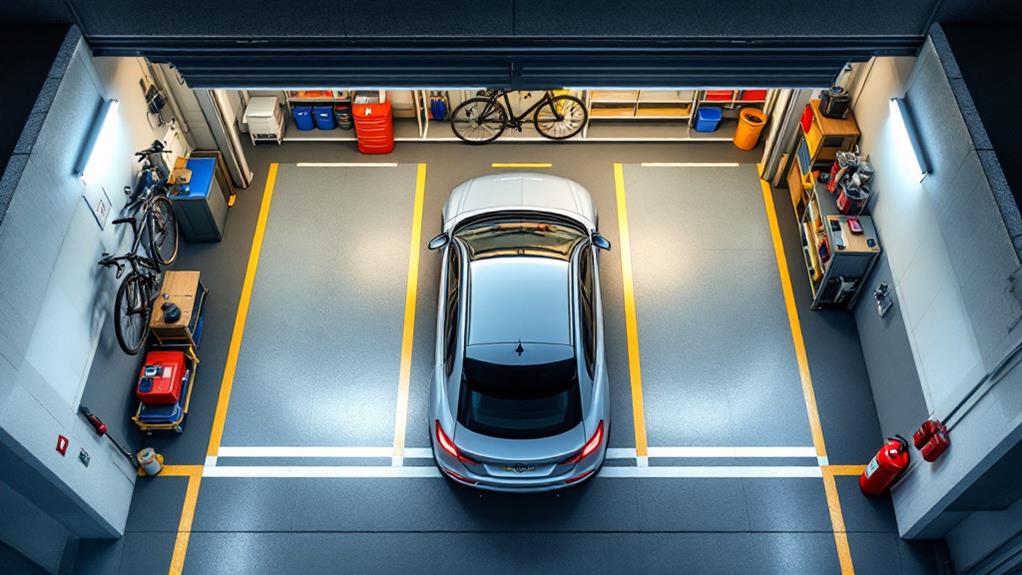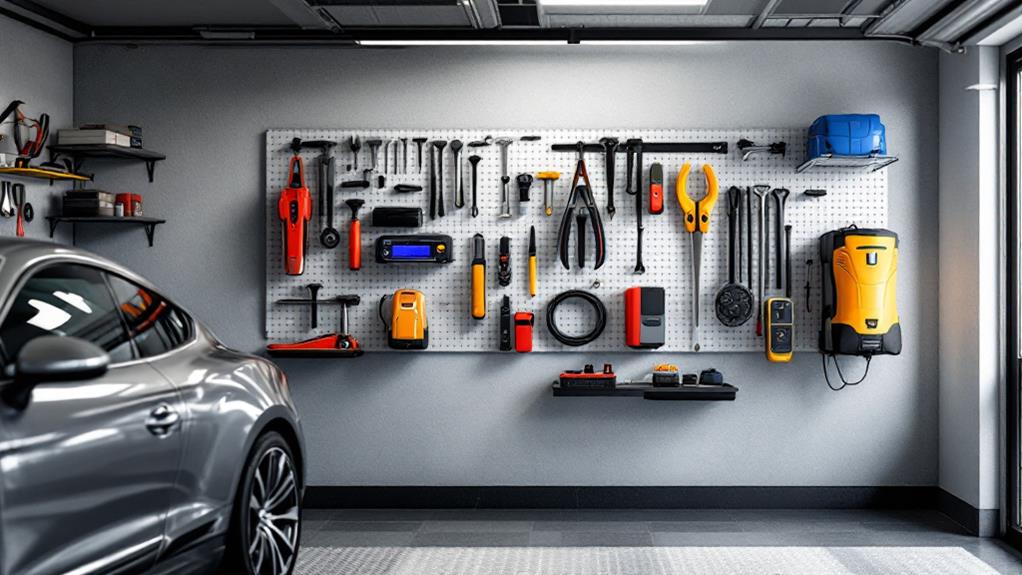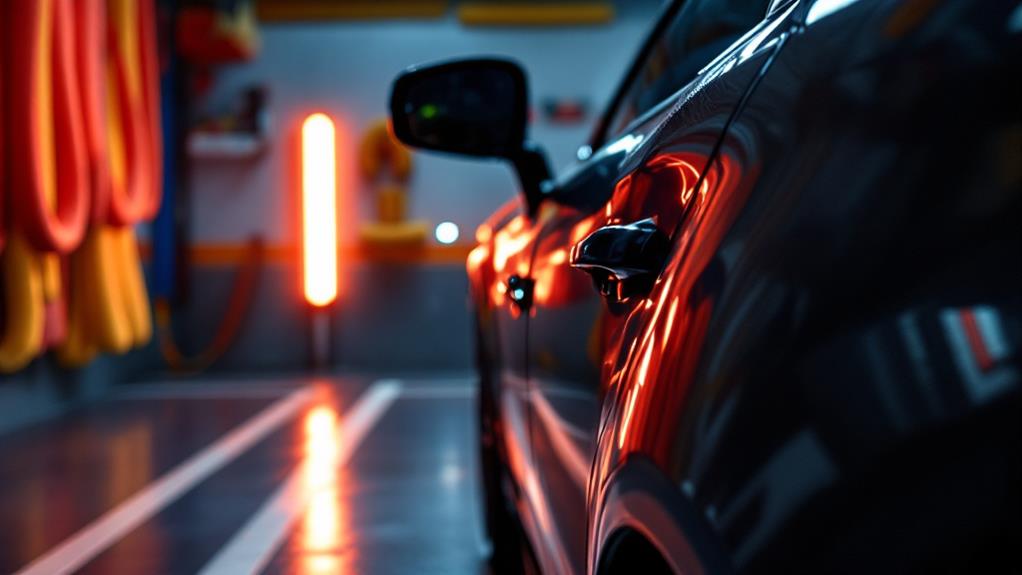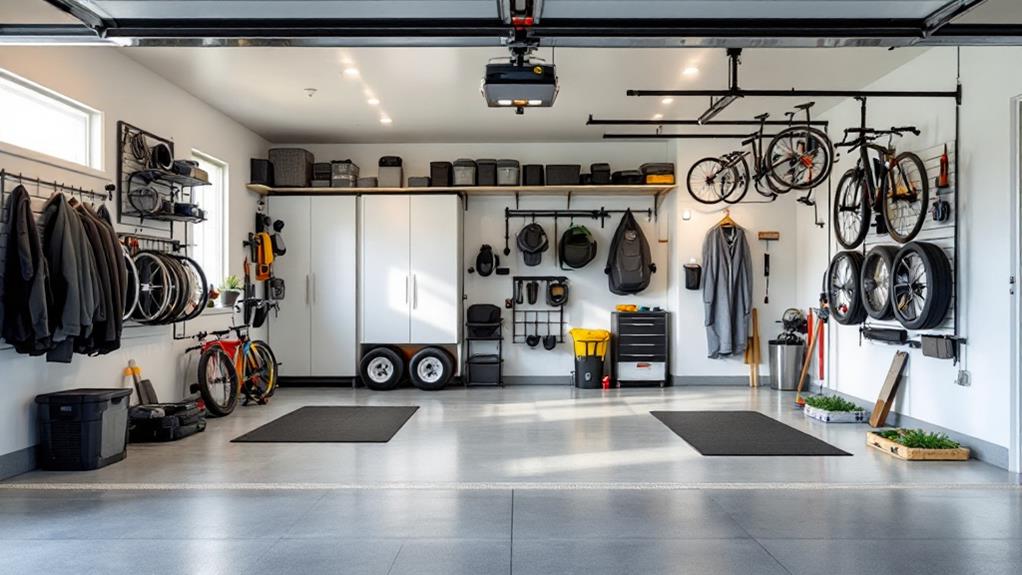DIY Solutions for Setting Up a Parking Stop in Your Garage
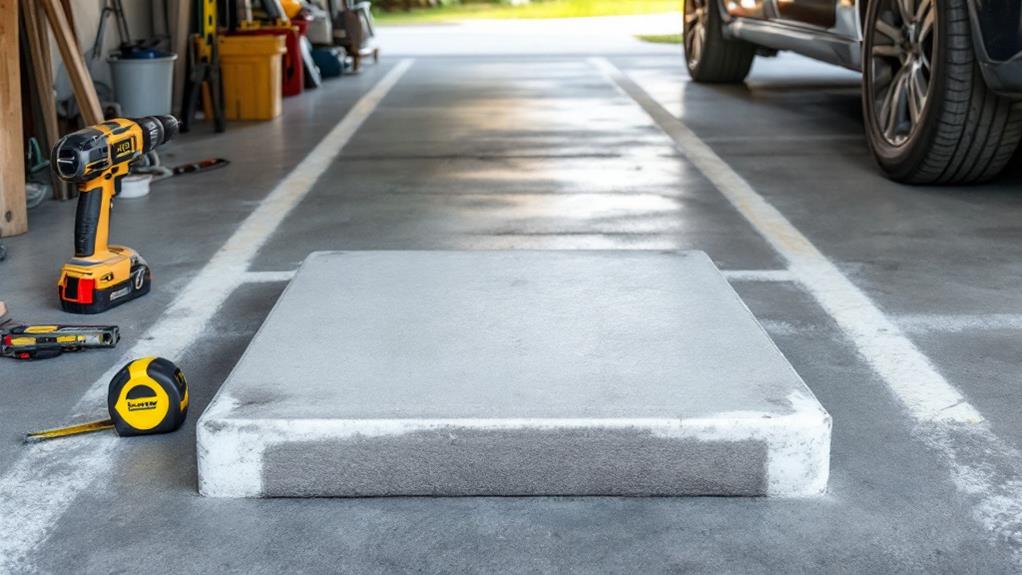
You can easily set up a DIY parking stop in your garage to prevent vehicle damage and guarantee safe parking. Start by evaluating your garage space and choosing a suitable stop type. Popular DIY options include using tennis balls, rubber stops, or constructing a triangular tube stop with steel. Install your chosen stop securely, considering your vehicle's size and weight. Enhance visibility with bright colors or reflective materials. Remember to maintain your parking stop regularly for ideal performance. Whether you opt for a simple tennis ball or a more elaborate sensor system, there's a DIY solution to fit your needs and budget. Investigate further to uncover the perfect parking stop for your garage.
Understanding Garage Parking Challenges
Garages can be treacherous for parked cars, especially those with manual transmissions. You might think your vehicle is secure, but several factors can lead to unexpected movement. Manual transmission cars are particularly prone to rolling away if you haven't engaged the parking brake properly. Even if you've set the brake, user error can still occur, leaving your car vulnerable to movement.
You can't always rely on engine compression to keep your car in place, as it's often inadequate for secure parking. This creates a substantial risk, especially in sloped garages or when you're parked facing the garage door. A rolling car can cause severe damage to your property or even injure someone.
The lack of a consistent, easy-to-use solution for preventing car movement in garages is a common problem. You need a reverse-facing parking stop that works reliably every time you park. A well-designed parking stop acts like a dependable backstop, similar to how a ball stops when it hits a wall. By addressing these challenges with a DIY parking stop, you'll greatly enhance the safety and security of your garage parking setup.
Assessing Your Garage Space
Prior to undertaking your DIY parking stop project, it's critical to thoroughly assess your garage space. Start by measuring the dimensions of your garage, paying close attention to the area where you'll position the car. Take note of any obstructions, such as shelving units or workbenches, that might affect your parking stop placement.
Consider the size and weight of your vehicles when selecting an appropriate parking stop solution. You'll want to guarantee that the stop can withstand the impact of your car without causing damage. Evaluate the space on either side of your parked vehicle to determine the best location for your parking stop.
Don't forget to check for any local building codes or homeowner's association restrictions that might impact your installation. These regulations could affect the type of parking stop you can use or its placement within your garage.
Assess how frequently you'll use the parking stop and consider accessibility needs. If you park multiple vehicles in your garage, you may need to plan for more than one stop. Finally, examine the area near your garage door to ensure your parking stop won't interfere with its operation.
Choosing the Right Parking Stop
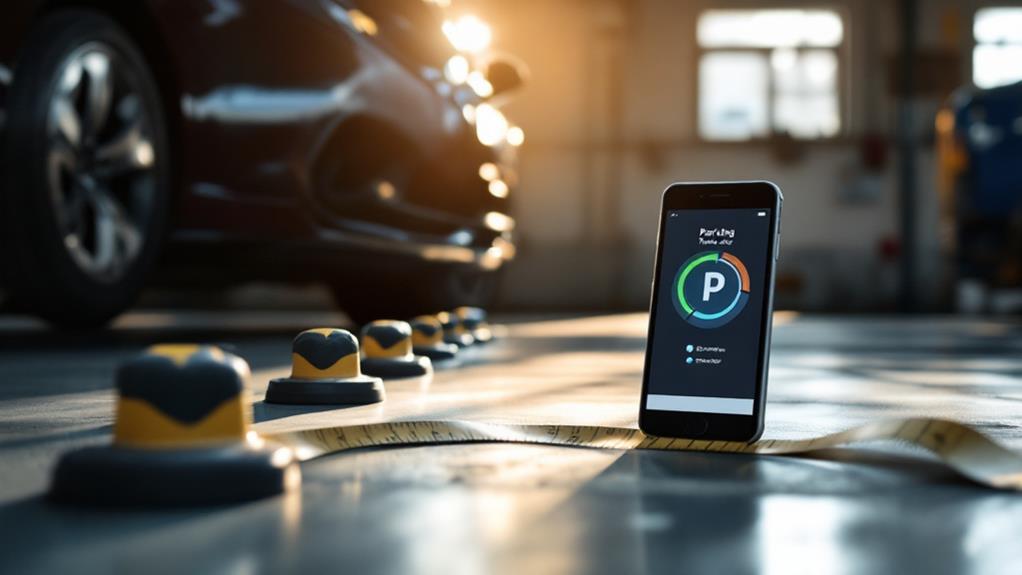
When it comes to selecting the ideal parking stop for your garage, you'll need to ponder several factors. First, consider the type of vehicle you own and how it fits in your parking spot. Different cars require different stopping distances, so choose a solution that's versatile enough to accommodate various vehicle sizes.
A popular and cost-effective option is the tennis ball hanging method. It works well for most situations and can easily act as a parking guide. Simply suspend a tennis ball from the ceiling, positioning it so it touches your windshield when you're in the right spot. This method is adjustable and doesn't take up floor space.
For a more permanent solution, consider rubber or plastic parking stops. These are durable and can be secured to the garage floor. They're ideal if you always park in the same spot and don't need to adjust for different cars.
If you prefer a high-tech approach, laser parking sensors are available. These project a beam onto your dashboard, indicating when you've reached the perfect parking position. While more expensive, they offer precision and a modern touch to your garage setup.
DIY Parking Stop Materials
Crafting your own parking stop can be a rewarding DIY project that saves money and allows for customization. When choosing materials for your DIY parking stop, you'll find several options that balance durability, cost, and ease of installation.
Pressure-treated lumber is a popular choice, with 2x4 or 2x6 boards cut to your desired length. This option is cost-effective and easy to work with, but you'll need to guarantee it's securely fastened to prevent sliding. For a more durable solution, consider rubber parking stops available at hardware stores. These provide excellent traction and won't damage your vehicle's tires or parking brake.
If you're handy with metalworking, steel angle iron or flat bar can be fabricated into a custom parking stop that's resistant to deformation. For a softer approach, thick plastic or polyurethane speed bumps can be secured to your garage floor. These are especially useful if you have a low-hanging garage door opener that could be damaged by a taller stop.
Don't overlook recycled materials for a budget-friendly option. Old tires or concrete blocks can be repurposed as makeshift parking stops. Just be sure to secure them properly, perhaps using an eye bolt for added stability.
Installation Techniques and Tips
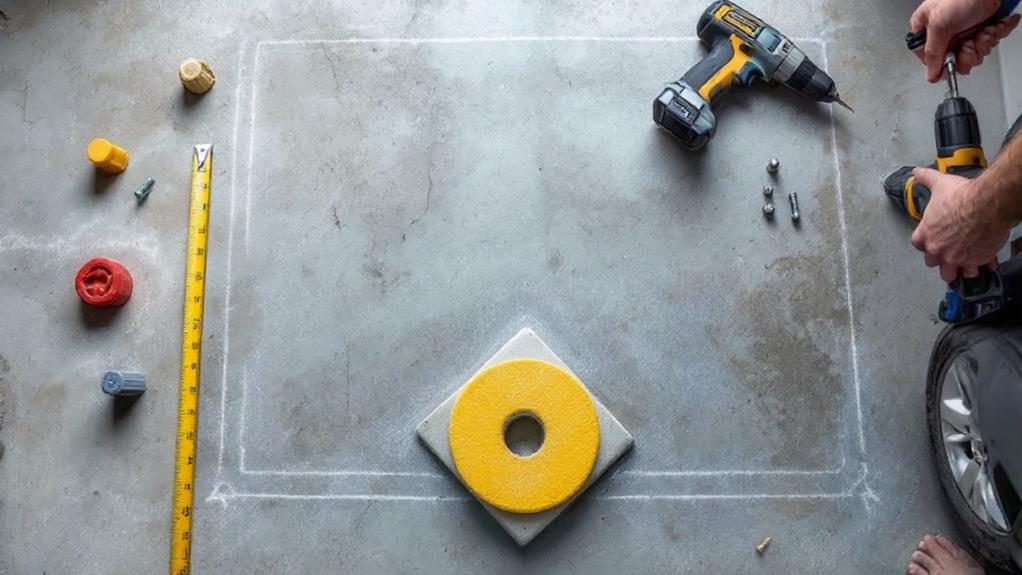
How you install your DIY parking stop can make all the difference in its effectiveness and longevity. When using rubber parking stops, guarantee you securely bolt them to the garage floor. This prevents them from shifting and maintains a reliable barrier for your car within the garage.
If you opt for a more sturdy solution, construct a triangular tube stop using steel angle and flat steel. This durable option can withstand repeated use and provides a sturdy barrier for your vehicle.
For a visual cue, hang a tennis ball on a string from your garage ceiling. Position it so that when your windshield touches the ball, you know you're in the perfect spot. Alternatively, paint a mark on the wall to align with your car door or mirror for a discreet guide.
To add a high-tech touch, install an ultrasonic or radar-based parking sensor system. These provide auditory and visual cues as you approach the garage wall, offering hands-free assistance.
Remember to carefully measure and mark your desired stopping point before installing any parking aids. This ensures you use the parking stop effectively and consistently each time you park.
Enhancing Parking Stop Visibility
Visibility is essential for any parking stop, especially in a dimly lit garage. To guarantee your DIY parking stop's visibility, start by painting it a bright color like yellow or orange. This simple step will make it stand out, even if you've used the tennis ball method. Don't forget the top edge, as it's the first part drivers will see when approaching.
To further improve visibility, install reflective tape or strips along the parking stop's surface. This will make things much easier to spot when your headlights shine on it. If you want to go the extra mile, consider using glow-in-the-dark paint or photoluminescent materials. These will help your parking stop remain visible even in low light conditions.
Position your painted bright parking stop in a well-lit area of your garage. If possible, incorporate motion-activated lighting nearby to illuminate the area when you drive in. Remember, the goal is to make your DIY solution as effective as a commercial parking stop. By enhancing its visibility, you'll reduce the risk of accidentally hitting it and ascertain you can use a parking stop safely and efficiently in your garage.
Maintaining Your Parking Stop Solution
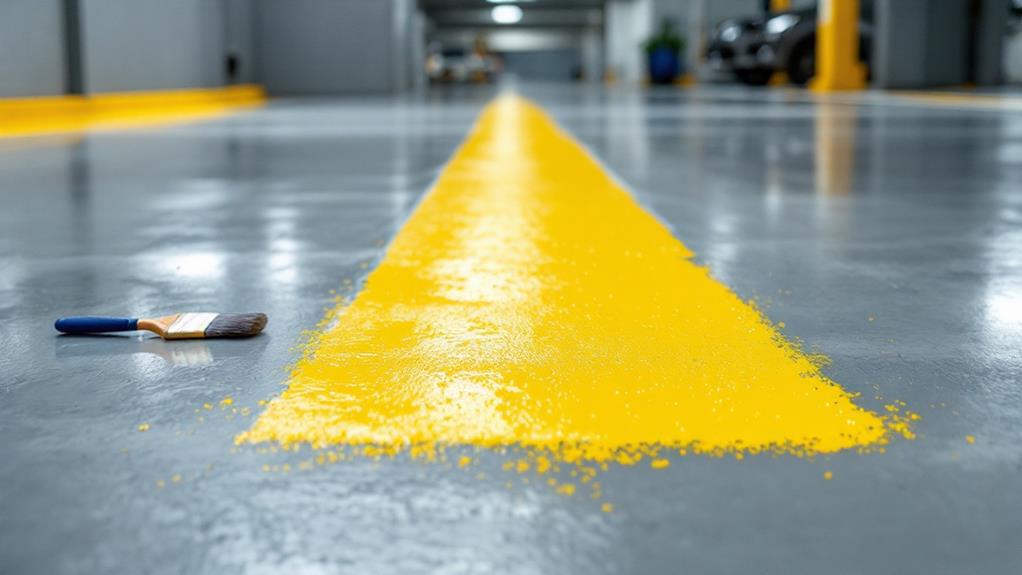
To safeguard your DIY parking stop remains productive over time, regular maintenance is crucial. Even though your parking stop works great initially, it is necessary to inspect it regularly for signs of wear or damage. Check that it's securely in place and hasn't shifted, confirming you still have enough room to maneuver on one side of your vehicle.
Periodically clean your parking stop to remove debris or buildup that could affect its performance. This is especially important if your garage light doesn't illuminate the area well, as you might miss potential issues. If you notice any deformation, cracks, or reduced resistance against vehicle movement, consider replacing the parking stop to maintain its effectiveness.
Educate all household members about the proper use and significance of the parking stop. This shared knowledge will help preserve its long-term functionality and prevent accidental damage. By following these maintenance steps, you'll guarantee your DIY parking stop continues to serve its purpose effectively, providing a reliable solution for safely parking your vehicle in the garage.
